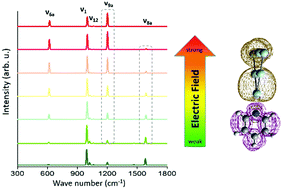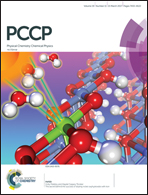Elucidation of charge-transfer SERS selection rules by considering the excited state properties and the role of electrode potential†
Abstract
The goal of this study is to shed light on the charge-transfer (CT) mechanism of surface-enhanced Raman scattering (SERS) by considering the properties of CT excited states. The calculations have been done by means of an excited-state gradient approximation for a pyridine molecule interacting with a silver cluster, and provided a satisfactory improvement in comparison to previous work. The effect of electrode potential on the SERS-CT spectra has been modelled theoretically by applying an external electric field for selected CT transitions and the enhancement of the ν6a and ν9a modes and a decline in the intensity of the ν8a mode under a negative electric field (which is directed toward the cluster) have been observed. These results match well with the experimental studies and also explain the effect of electrode potentials on the patterns of spectra, as experimental evidence of the CT mechanism. Finally, this study demonstrated that the excited state vector gradient can be used as a distinguishing factor to explain the SERS selection rules.



 Please wait while we load your content...
Please wait while we load your content...